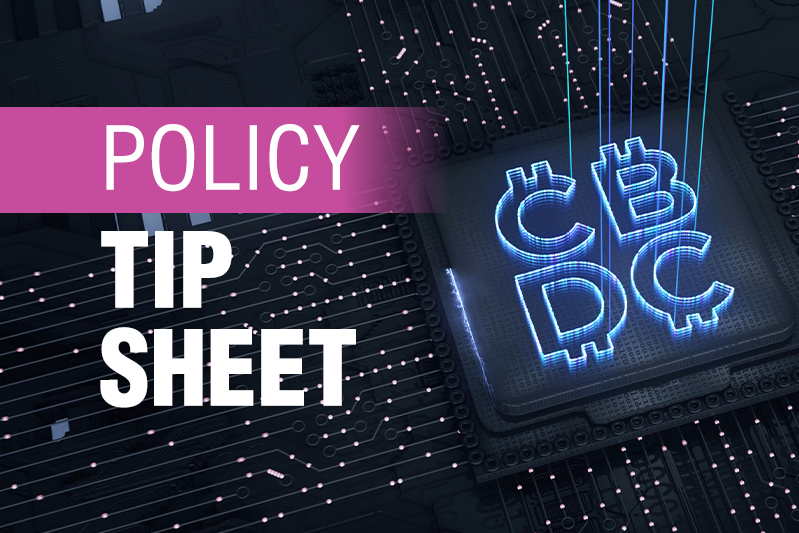Central bank digital currencies (CBDCs) have only recently become a widely discussed topic among influential figures in academia, media, and public policy institutions. However, initiatives to implement CBDCs around the globe have existed for years, especially in countries with autocratic governments, such as China and Russia. As of September 2023, 131 countries have explored CBDCs.[1] The Biden administration has also signaled that it’s supportive of a Federal Reserve-backed U.S. CBDC, a development that will be discussed further in a separate Tip Sheet.
A U.S. CBDC would pose a significant threat to individual liberty, because it would allow central planners to engineer society in accordance with their every objective, with little accountability or oversight. However, before getting into the details surrounding CBDCs, it is important to understand what a CBDC is and why it is being pushed so hard by some of the most powerful institutions and leaders in the world.
Digital Currencies, CBDCs, and Cryptocurrencies
Modern mainstream internet-dependent payment systems—including Venmo, Zelle, PayPal, online banking applications, debit cards, and credit cards—represent access to digital dollars and digital debt. These systems require a centralized and trusted third party, such as a banking institution, to conduct transactions between two or more people or businesses. This is the basis of our current banking and financial systems.
Investopedia defines digital currencies as “assets that are only used for electronic transactions. They do not have any physical form, although they can be exchanged for regular money or other assets.”[2] As its name suggests, a CBDC is a form of digital currency. The U.S. Federal Reserve defines a CBDC as “a digital form of central bank money that is widely available to the general public,” and refers to “central bank money” as “a liability of the central bank.”[3] Moreover, the Fed states that “a CBDC would differ from existing digital money available to the general public because a CBDC would be a liability of the Federal Reserve, not of a commercial bank.”[4]
Although cryptocurrencies such as Bitcoin are also digital currencies, cryptocurrencies and CBDCs are, in many ways, polar opposites.
One of the most important characteristics of cryptocurrencies, including Bitcoin, is that they are dependent on blockchain technology. Blockchain technology allows people to securely, efficiently, and anonymously transact with one another without the need for a trusted third-party institution like a bank.
CBDCs, on the other hand, require a centralized authority such as the Fed or a government institution. Some CBDC designs operate using “authorized” (private) blockchains, in which users must be invited to join the network. Users’ identities are linked to an existing account with the central bank, along with other data that would enable the creation of digital identification for every user.
CBDC designs typically put central banks in charge of managing the CBDC, with varying degrees of involvement from government institutions. CBDCs are also often programmable. In practice, that means they can be designed so that users can be tracked and their activity controlled by the institutions in charge of managing the CBDC.
Central Banks
Over the past century, in the United States and throughout the rest of the industrialized world, central bankers and governments have amassed an escalating level of oligarchic control over society, beginning with the creation of the Fed and strengthened by the development of the Bretton Woods international monetary system in the waning days of World War II. The relinquishment of the gold standard in 1971 and the subsequent transition to a completely “fiat” system of monetary policy further cemented their control.[5]
Over the past decade, only the advent of cryptocurrencies has presented central bankers with a substantial threat to their power, because cryptocurrencies permit individuals and companies to transact with one another without a middleman. This is why many central-banking elites have attempted to disparage and regulate cryptocurrencies whenever possible.
For instance, in an interview with World Economic Forum Chairman Klaus Schwab, conducted in August 2021, European Central Bank President Christine Lagarde stated, “I think that all cryptocurrencies alleged to be cryptocurrencies are not currencies at all. They are speculative assets … an asset is an asset and has to be regulated as such, it has to be supervised by the asset regulators and supervisors.”[6]
CBDCs are the central bankers’ primary solution to the threat cryptocurrencies pose to their power, and central bankers have not been shy about how they intend to utilize CBDCs to achieve ideological goals and limit individual privacy. Agustin Carstens—general manager of the Bank of International Settlements, known as the “central bank of central banks”—infamously stated, “We don’t know who’s using a $100 bill today and we don’t know who’s using a $1,000 peso bill today. The key difference with the CBDC is the central bank will have absolute control on the rules and regulations that will determine the use of that expression of central bank liability, and we also will have the technology to enforce that.”[7]
CBDC Programmability
Agustin’s comments about the ability to track the use of CBDCs is a reference to their programmability. Because CBDCs are digital and controllable by a centralized authority, they can be programmed with features that allow governments, banks, or other authorized institutions to see what people are purchasing with CBDCs, or even to prevent purchases from occurring altogether.[8] This is precisely what makes CBDCs so dangerous to liberty.
For example, a U.S. CBDC could be programmed by the Fed or federal government so that some or all users can only spend money on approved items at allotted times, allowing centralized authorities to effectively control most activities, including basic human rights like the freedom to travel. CBDCs could also be programmed to make certain actions, products, or services costlier for some groups, or punish or reward users for saving or spending.
Programmable CBDCs could and likely would be used to promote numerous policy objectives without the need for formal legislation, such as battling climate change by controlling the use of fossil fuels. CBDCs could also be designed to make it more difficult to purchase firearms or ammunition.
Further, CBDCs would have a profound impact on monetary and economic policy generally. They could be used to shrink individuals’ bank account balances, for example, through the use of personalized negative interest rates, or by more easily creating vast amounts of new money to “stimulate” economic activity. The coercive capacity of a programmable CBDC is virtually limitless.
Policy Recommendations
First, legislators could push back against any alterations to state or federal legal codes that would change the definition of money to facilitate a CBDC.[9]
Second, legislators could revise the definition of “deposit accounts” in state legal codes so that a CBDC could not be used as a “deposit” in state-regulated banks. For more information about this strategy, see our Tip Sheet about the Uniform Commercial Code and the definition of money.[10]
Third, state legislatures could pass laws that recognize gold and silver as “legal tender,” a move that is plainly supported by the U.S. Constitution.[11] This could serve as an important escape hatch in the event that a CBDC is imposed by the Fed in the future.
Fourth, state legislatures could pass laws that make it easier for citizens and businesses to store gold and silver legal tender, as well as to transact using gold and silver.[12]
Fifth, states could pass laws that ban state and local law enforcement from helping federal officials confiscate paper money, in the event that paper money is banned by the federal government. Exceptions could be made for appropriate criminal convictions.
Sixth, Congress could pass a law prohibiting the Fed or any federal government agency from issuing, studying, designing, or formally supporting a CBDC, now or in the future.
Notes
[1] Atlantic Council, “Central Bank Digital Currency Tracker,” Accessed September 15, 2023, https://www.atlanticcouncil.org/cbdctracker/
[2] Jake Frankenfield, “Digital Currency Types, Characteristics, Pros & Cons, Future Uses,” Investopedia, Updated April 20, 2023, https://www.investopedia.com/terms/d/digital-currency.asp#:~:text=Digital%20currencies%20are%20assets%20that,regular%20money%20or%20other%20assets.
[3] Board of Governors of the Federal Reserve System, “What is a Central Bank Digital Currency?” Federalreserve.gov, Updated January 20, 2022, https://www.federalreserve.gov/faqs/what-is-a-central-bank-digital-currency.htm
[4] Board of Governors of the Federal Reserve System, “What is a Central Bank Digital Currency?”
[5] Federal Reserve Bank of Minneapolis, “A History of Central Banking in the United States,” Accessed March 24, 2023, https://www.minneapolisfed.org/about-us/our-history/history-of-central-banking; Corbettreport.com, “Century of Enslavement: The History of the Federal Reserve,” July 6, 2014, https://www.corbettreport.com/federalreserve/
[6] European Central Bank, “Interview with Christine Lagarde, President of the ECB, conducted by Klaus Schwab, Founder and Executive Chairman of the World Economic Forum, on 30 August 2021,” September 1, 2021, https://www.ecb.europa.eu/press/inter/date/2021/html/ecb.in210901_1~171c7b19d0.en.html
[7] Agustin Carstens, “Cross-Border Payment—A Vision for the Future,” youtube.com, October 19, 2020, https://www.youtube.com/watch?v=9FM4Fu2ujDE
[8] IBM, “What are smart contracts on blockchain?” Accessed September 15, 2023, https://www.ibm.com/topics/smart-contracts
[9] See: Justin Haskins, “6 Facts Every Lawmaker Needs to Know About the 2022 UCC Amendments and Central Bank Digital Currencies,” The Heartland Institute, March 22, 2023, https://heartland.org/publications/6-facts-every-lawmaker-needs-to-know-about-the-2022-ucc-amendments-and-central-bank-digital-currencies/
[10] See: Justin Haskins, “6 Facts Every Lawmaker Needs to Know About the 2022 UCC Amendments and Central Bank Digital Currencies.”
[11] United States Constitution, Article I, Section 10, Clause 1.
[12] See: Transactionalgold.com, “Constitutional Texas-Based Transactional (Gold & Silver) Currency,” Accessed September 15, 2023, https://transactionalgold.com/
Jack McPherrin is a writer, editor, and researcher with The Henry Dearborn Liberty Network. He also serves as The Heartland Institute’s research editor and as a research fellow within Heartland’s Socialism Research Center (SRC). As research editor, Jack sources, edits, and manages the publication process for all Heartland research publications, and regularly writes op-eds for various news outlets, including The Epoch Times, The Blaze, The Washington Times, The Western Journal, The Center Square, American Greatness, Townhall, American Thinker, and RedState, among others. As an SRC research fellow, Jack authors his own research publications, policy studies, and legislative tip sheets; he focuses most heavily upon authoritarian tactics, collectivist ideology, technocracy, environmental, social, and governance (ESG) systems, and international affairs relevant to American society. Jack is also the managing editor of the SRC’s website, StoppingSocialism.com.
Jack holds a Master of Arts in International Affairs from Loyola University-Chicago and a Bachelor of Arts in Economics and History from Boston College. Prior to his tenure at Heartland and the completion of his graduate degree, Jack worked in the private sector in Chicago, where he still resides.





